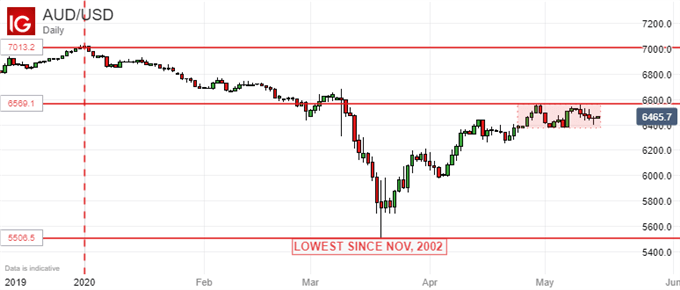Fundamental Australian Dollar Forecast: Bearish
- The Australian Dollar has gained along with other assets with a similar risk profile
- However, the looming global recession is likely to see those assets’ chances rethought
- There’s a lot of painful data to come, just not in the coming week
The Australian Dollar faces another week of rather scant domestic economic news which is all-too likely to leave the coronavirus in charge of market direction.
Investors can look forward to the minutes of May 5’s monetary policy meeting at the Reserve Bank of Australia but they’ll struggle to add much to the backdrop already in place. The central bank left interest rates on hold at record lows this month, having reduced them sharply in March.
However, the markets already know that all stimulus options remain on the table at the RBA, and that it expects this year’s first half to be extremely bleak. Policy makers may be unconvinced that still-lower rates are going to help much, but the prospect of increases, or indeed any form of monetary tightening, is now a long way in the future. The minutes won’t change this perception when they’re released on Tuesday.
More than Half a Million Australians Lost Their Jobs Last Month
The latest indicator, Australian unemployment data, were catastrophic, but on balance no more so than expected. Overall job losses of 594,300 beat forecasts, but the jobless rate came in better than expected. However, with that rate at 6.2%, and the RBA predicting a peak above 10%, the market will be braced for more dreadful labor data in the months ahead,
All up this doesn’t look like a particularly supportive environment for the Australian Dollar but, given the travails of every national economy in the face of the Covid outbreak, its’ arguable that the currency is no worse off on a comparative basis.
However, all such growth-correlated assets have seen their bullish impetus wane in the past two weeks. AUD/USD’s peak of April 29 at 65.69 has not been topped since, even if it is not too far away from current levels.

Huge monetary rescue programs may have lifted them from their March lows by heading off the grim chance of an explosive credit crunch. But they still have to deal with global recession and the possibility that reopening economies will prove more difficult than closing them.
With this in mind it’s a cautiously bearish call again for the Australian Dollar this week.



Australian Dollar Resources for Traders
Whether you’re new to trading or an old hand DailyFX has plenty of resources to help you. There’s our trading sentiment indicator which shows you live how IG clients are positioned right now. We also hold educational and analytical webinars and offer trading guides, with one specifically aimed at those new to foreign exchange markets. There’s also a Bitcoin guide. Be sure to make the most of them all. They were written by our seasoned trading experts and they’re all free.
--- Written by David Cottle, DailyFX Research
Follow David on Twitter @DavidCottleFX or use the Comments section below to get in touch!




